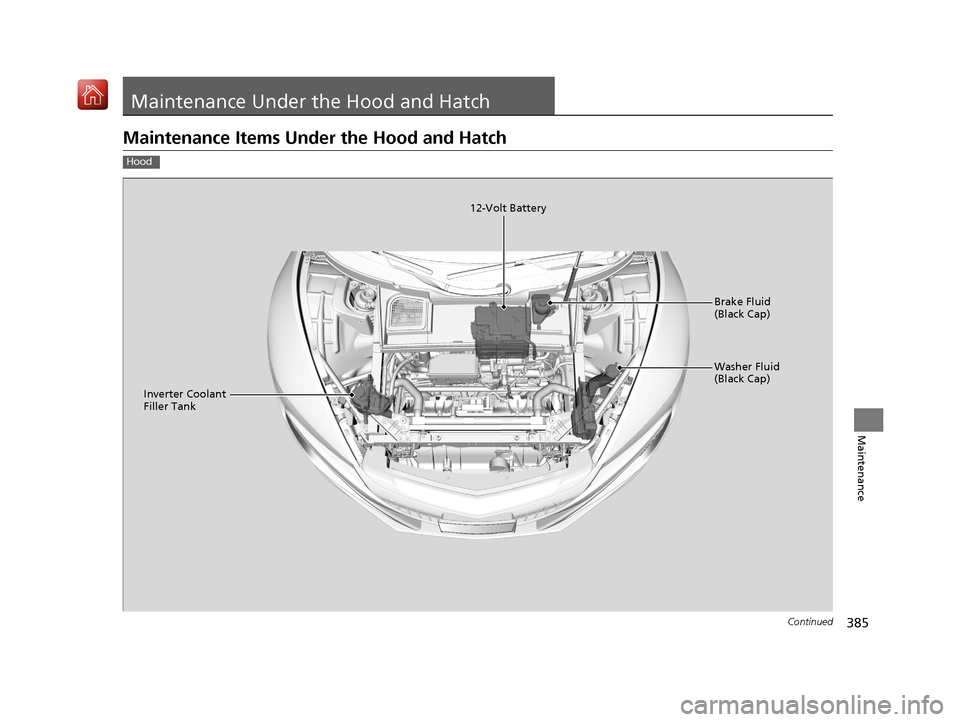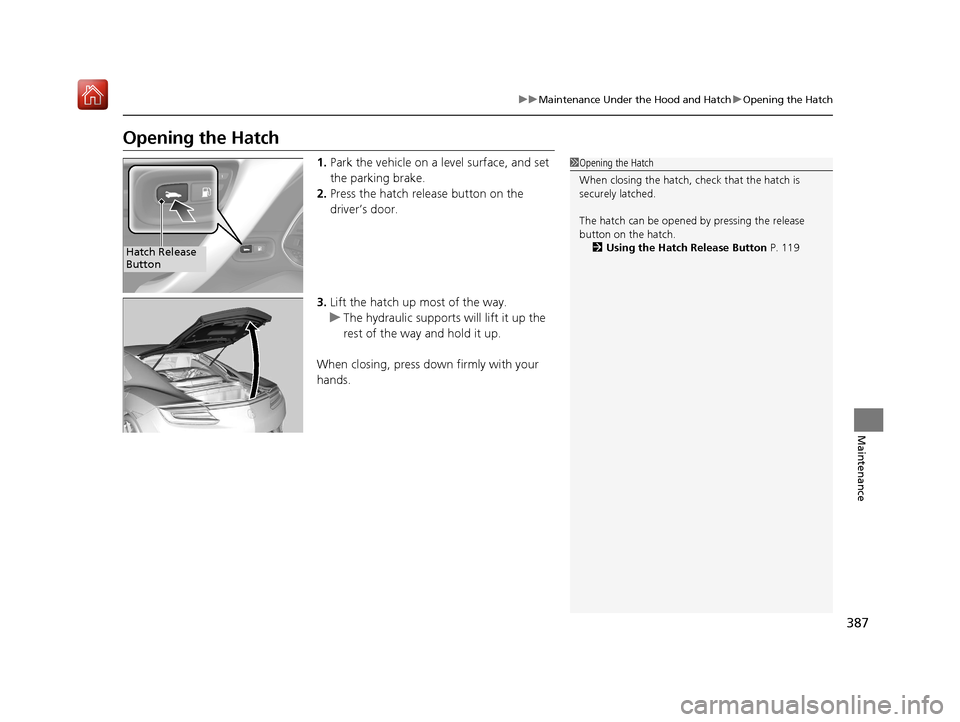2018 Acura NSX brake
[x] Cancel search: brakePage 376 of 489

375
Maintenance
This chapter discusses basic maintenance.
Before Performing MaintenanceInspection and Maintenance ............ 376
Safety When Performing Maintenance .... 377Parts and Fluids Used in Maintenance Service ........................................... 378
Maintenance Minder
TM..................... 379
Maintenance Under the Hood and Hatch Maintenance Items Under the Hood and Hatch ............................................. 385
Opening the Hatch .......................... 387
Opening the Hood ........................... 388
Engine Compartment Cover ............. 389
Recommended Engine Oil ................ 390
Oil Check ......................................... 391
Adding Engine Oil ............................ 394 Cooling System ................................ 396
Inverter Coolant ............................... 398
Transmission Fluids .......................... 399
Brake Fluid ....................................... 400
Refilling Window Washer Fluid......... 400
Replacing Light Bulbs ....................... 401Checking and Maintaining Wiper Blades.... 404Checking and Maintaining Tires
Checking Tires ................................. 407
Tire and Loading Information Label ..... 408Tire Labeling .................................... 408DOT Tire Quality Grading (U.S. Vehicles) ...... 410Wear Indicators................................ 412
Tire Service Life ................................ 412
Tire and Wheel Replacement............ 413 Tire Rotation .................................... 414
Winter Tires ..................................... 415
Cold Weather Driving ...................... 416
12-Volt Battery ................................. 417
Remote Transmitter Care Replacing the Button Battery ........... 418
Climate Control System Maintenance.... 419CleaningInterior Care .................................... 420
Exterior Care.................................... 422
Accessories and Modifications Accessories ...................................... 426
Modifications................................... 427
Storage .............................................. 428
18 NSX-31T6N6100.book 375 ページ 2017年10月27日 金曜日 午後1時39分
Page 377 of 489

376
Maintenance
Before Performing Maintenance
Inspection and Maintenance
For your safety, perform all listed inspections and maintenance to keep your vehicle
in good condition. If you become aware of any abnormality (noise, smell, insufficient
brake fluid, oil residue on the ground, etc .), have your vehicle inspected by an
authorized Acura NSX dealer. (Note, however, that service at an authorized Acura
NSX dealer is not mandatory to keep your warranties in effect.)
■Daily inspections
Perform inspections before long distance trips, when washing the vehicle, or when
refueling.
■Periodic inspections
• Check the brake fluid level monthly.
2 Brake Fluid P. 400
•Check the tire pressure monthly. Examin e the tread for wear and foreign objects.
2Checking and Maintaining Tires P. 407
•Check the operation of the exterior lights monthly.
2 Replacing Light Bulbs P. 401
•Check the condition of the wiper bl ades at least every six months.
2Checking and Maintaining Wiper Blades P. 404
■Types of Inspection and Maintenance
1Inspection and Maintenance
Maintenance, replacement, or repair of
emissions control devices and systems may be
done by any automotive repair establishment or
individuals using parts that are “certified” to
EPA standards.
According to state and fede ral regulations, failure to
perform maintenance on the maintenance main
items marked with # will not void your emissions
warranties. However, all maintenance services should
be performed in accordan ce with the intervals
indicated by the driver information interface.
2 Maintenance Service Items P. 382
If you want to perform complex maintenance tasks
that require more skills a nd tools, you can purchase a
subscription to the Service Express website at
www.techinfo.honda.com .
2 Authorized Manuals P. 477
If you want to perform ma intenance yourself, make
sure that you have the necessary tools and skills first.
After performing ma intenance, update the records in
the separate maintenance booklet.
U.S. models
18 NSX-31T6N6100.book 376 ページ 2017年10月27日 金曜日 午後1時39分
Page 378 of 489

377
uuBefore Performing Maintenance uSafety When Performing Maintenance
Maintenance
Safety When Performing Maintenance
Some of the most important safe ty precautions are given here.
However, we cannot warn you of every conceivable hazard that can arise in
performing maintenance. Only you can decide whether you should perform a given
task.
• To reduce the possibility of fire or explos ion, keep cigarettes, sparks, and flames
away from the 12-volt battery, all High Volt age system, and all fuel related parts.
• Never leave rags, towels, or other flam mable objects under the hood and hatch.
u Heat from the engine and exhaust can ignite them, causing a fire.
• To clean parts, use a co mmercially available degreaser or parts cleaner, not
gasoline.
• Wear eye protection and pr otective clothing when working with the 12-volt
battery or compressed air.
• Engine exhaust contains carbon monoxide, which is poisonous and can kill you.
u Only operate the engine if th ere is sufficient ventilation.
• The vehicle must be in a stationary condition.
u Make sure your vehicle is parked on le vel ground, the parking brake is set, and
the power system is turned off.
• Be aware that hot parts can burn you.
u Make sure to let the power system, including the engine and exhaust system,
cool thoroughly before touching vehicle parts.
• Be aware that moving parts can injure you.
u Do not activate the power system unle ss instructed, and keep your hands and
limbs away from moving parts. When the power system is on, the engine can
automatically start, or the radiator fa n may start operating without the engine
running.
■Maintenance Safety
■Vehicle Safety
1 Safety When Performing Maintenance
3WARNING
Improperly maintaining this vehicle or
failing to correct a pr oblem before driving
can cause a crash in which you can be
seriously hurt or killed.
Always follow the inspection and
maintenance recommendations according
to the schedules in this owner’s manual.
3WARNING
Failure to properly follow maintenance
instructions and prec autions can cause you
to be seriously hurt or killed.
Always follow the procedures and
precautions in this owner’s manual.
18 NSX-31T6N6100.book 377 ページ 2017年10月27日 金曜日 午後1時39分
Page 383 of 489

382
uuMaintenance MinderTMuTo Use Maintenance MinderTM
Maintenance
■Maintenance Service Items1Maintenance Service Items
•Independent of the Maintenance Minder
information, replace the brake fluid every 3 years.
•Adjust the valves during services A, B, 1, 2, or 3 if
they are noisy.
•Inspect direct injection + port injection fuel system
every 3 years or service item B is indicated.
•Inspect tire condition ev ery 3,100 miles (5,000 km).
Maintenance Minder Message System Message
Indicator
Main Item Sub Items
*1: If a message SERVICE does not appear more than 12 months after the display is reset, change the
engine oil every year.
# : See information on maintenance and emissions warranty.
CODEMaintenance Main Items
A
●Replace engine oil*1
B●Replace engine oil*1 and oil filter●Inspect front and rear brakes●Check expiration date for temporary tire repair kit
bottle
●Inspect tie rod ends, steering gearbox, and boots●Inspect suspension components●Inspect driveshaft boots●Inspect brake hoses and li nes (Including ABS/VSA)●Inspect all fluid levels and condition of fluids●Inspect exhaust system#
●Inspect fuel lines and connections#
●Inspect direct injection + port injection fuel system*2: If you drive in dusty conditions, replace the air cleaner element every 15,000 miles (24,000 km).
*3: If you drive primarily in urban areas that have high concentrations of soot in the air from industry and
from diesel-powered vehicles, replace the dust and pollen filters every 15,000 miles (24,000 km) or
every year.
*4: Driving in mountainous areas at very low vehicle speeds results in higher transmission temperature. This requires transmission fluid and clutch fluid changes more frequently than recommended by the
Maintenance Minder. If you regularly drive your vehicle under this condition, have the transmission
fluid and clutch fluid changed every 20,000 miles (32,000 km).
*5: Driving in mountainous areas at very low vehicle speeds results in higher level of mechanical (Shear) stress to fluid. This requires Twin Motor Unit fluid changes more frequently than recommended by the
Maintenance Minder. If you regularly drive your vehicle under these conditions, have the Twin Motor
Unit fluid changed at 7,500 miles (12,000 km), then every 15,000 miles (24,000 km).
CODEMaintenance Sub Items
1
●Inspect tire condition
2●Replace air cleaner element*2
●Replace dust and pollen filters*3
3●Replace transmission fluid*4
●Replace clutch fluid*4
4●Replace spark plugs●Inspect valve clearance●Inspect Active Exhaust Valve function●Replace Intake Sound Control
5
●Replace engine coolant
6●Replace Twin Motor Unit fluid*5
18 NSX-31T6N6100.book 382 ページ 2017年10月27日 金曜日 午後1時39分
Page 386 of 489

385Continued
Maintenance
Maintenance Under the Hood and Hatch
Maintenance Items Under the Hood and Hatch
Hood
Brake Fluid
(Black Cap)
Washer Fluid
(Black Cap)
12-Volt Battery
Inverter Coolant
Filler Tank
18 NSX-31T6N6100.book 385 ページ 2017年10月27日 金曜日 午後1時39分
Page 388 of 489

387
uuMaintenance Under the Hood and Hatch uOpening the Hatch
Maintenance
Opening the Hatch
1. Park the vehicle on a level surface, and set
the parking brake.
2. Press the hatch release button on the
driver’s door.
3. Lift the hatch up most of the way.
u The hydraulic supports will lift it up the
rest of the way and hold it up.
When closing, press down firmly with your
hands.1 Opening the Hatch
When closing the hatch, check that the hatch is
securely latched.
The hatch can be opened by pressing the release
button on the hatch.
2 Using the Hatch Release Button P. 119
Hatch Release
Button
18 NSX-31T6N6100.book 387 ページ 2017年10月27日 金曜日 午後1時39分
Page 389 of 489

388
uuMaintenance Under the Hood and Hatch uOpening the Hood
Maintenance
Opening the Hood
1. Park the vehicle on a level surface, and set
the parking brake.
2. Pull the hood release handle under the
driver’s side lower co rner of the dashboard.
u The hood will pop up slightly.
3. Pull up the hood latch lever (located under
the front edge of the hood to the center)
and raise the hood. On ce you have raised
the hood slightly, you can release the lever.
4. Lift the hood up most of the way.
u The hydraulic support will lift it up the
rest of the way and hold it up.
When closing, lower it to approximately 12
inches (30 cm), then pr ess down firmly with
your hands, and make su re both right and left
latches are firmly locked in place.1 Opening the Hood
NOTICE
Do not open the hood when the wiper arms are
raised. The hood will strike the wipers, resulting in
damage to the hood and/or the wipers.
When closing the hood, check that both right and
left latches are securely latched.
If the hood latch lever moves stiffly, or if you can
open the hood without lifti ng the lever, the latch
mechanism should be cleaned and lubricated.
Pull
Hood Release Handle
Lever
18 NSX-31T6N6100.book 388 ページ 2017年10月27日 金曜日 午後1時39分
Page 401 of 489

400
uuMaintenance Under the Hood and Hatch uBrake Fluid
Maintenance
Brake Fluid
The fluid level should be between the MIN
and MAX marks on the side of the reserve
tank.
Refilling Window Washer Fluid
If the washer fluid is low, a message appears on the dr iver information interface.
Pour the washer fluid carefully. Do not overflow the reservoir.
Specified fluid: Acura Heavy Duty Brake Fluid DOT 4
■Checking the Brake Fluid
1Brake Fluid
NOTICE
Brake fluid marked DOT 5 is not compatible with your
vehicle’s braking system and can cause extensive
damage.
If the specified brake fluid is not available, you should
use only DOT 4 fluid from a sealed container as a
temporary replacement.
Using any non-Acura brake fl uid can cause corrosion
and decrease the longevity of the system. Have the
brake system flushed and re filled with Acura Heavy
Duty Brake Fluid DOT 4 as soon as possible.
If the brake fluid level is at or below the MIN mark,
have an authorized Acura NSX dealer inspect the
vehicle for leaks or worn brake pads as soon as
possible.
MINReserve Tank
MAX
1 Refilling Window Washer Fluid
NOTICE
Do not use engine antifreeze or a vinegar/water
solution in the windshield washer reservoir.
Antifreeze can damage y our vehicle’s paint. A
vinegar/water solution ca n damage the windshield
washer pump.
Use only commercially avai lable windshield washer
fluid.
Avoid prolonged use of hard water to prevent lime
scale build up.
18 NSX-31T6N6100.book 400 ページ 2017年10月27日 金曜日 午後1時39分